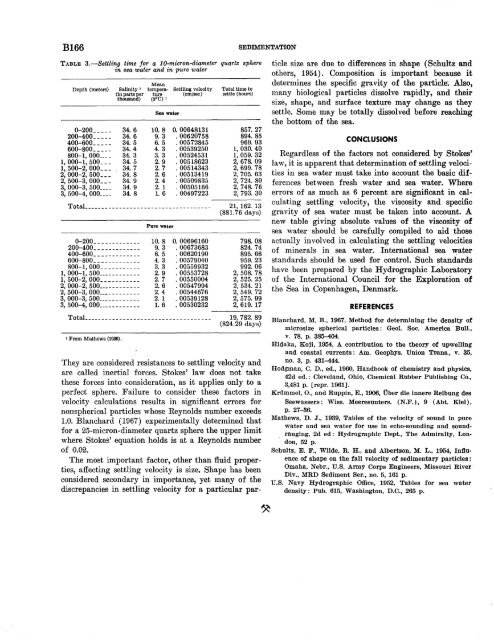RESEARCH· ·1970·
RESEARCH· ·1970·
RESEARCH· ·1970·
You also want an ePaper? Increase the reach of your titles
YUMPU automatically turns print PDFs into web optimized ePapers that Google loves.
B166<br />
TABLE 3.-Settling time for a 1 O-micron-diameter quartz sphere<br />
in sea water and in pure water<br />
Mean<br />
Depth (meters) Salinity 1 tempel1\- Settling velocity<br />
(in parts per ture (em/sec)<br />
thousand) (0°0) 1<br />
0-200 ____ _ 34. 6 10. 8 0. 00648131<br />
200-400 ____ _ 34. 6 9. 3 . 00620758<br />
400-600 ____ _ 34. 5 6. 5 . 00572845<br />
600~800 ____ _ 34.4 4. 3 . 00539250<br />
34. 3 3. 3 . 00524531<br />
34. 5 2. 9 . 00518623<br />
34. 7 2. 7 . 00514343<br />
34. 8 2. 6 . 00513419<br />
34. 9 2. 4 . 00509835<br />
34. 9 2. 1 . 00505166<br />
34. 8 1.6 . 00497223<br />
Total ___________________________________ _<br />
800-1, ooo ___ _<br />
1,000-1,500 __ 1, 500-2, ooo __ _<br />
2,000-2,500 __ _<br />
2, 500-3,000 __ _<br />
3, 000-3, 500 ___ 3, 500-4, ooo ___ _<br />
0-200 ____________ _<br />
200-400 ____________ _<br />
400-600 ____________ _<br />
600-800 ____________ _<br />
800-1,000 __________ _<br />
1, 000-1, 500 ___________ _<br />
1,500-2,000 __________ _<br />
2, 000-2, 500 ___________ _<br />
2, 500-3, ooo ___________ _<br />
~000-~500 ___________ _<br />
~500-4,000 ___________ _<br />
Sea water<br />
Pure water<br />
10. 8 0. 00696160<br />
9. 3 . 00673683<br />
6. 5 . 00620190<br />
4. 3 . 00579040<br />
3. 3 . 00559932<br />
2. 9 . 00553728<br />
2. 7 . 00550004<br />
2. 6 . 00547994<br />
2. 4 . 00544676<br />
2. 1 . 00539128<br />
1.6 . 00530232<br />
Total ___________________________________ _<br />
1 From Mathews (1939).<br />
Total time to<br />
settle (hours)<br />
SEDIMENTATION<br />
857. 27<br />
894. 85<br />
969. 93<br />
1, 030. 40<br />
1, 059. 32<br />
2,678. 09<br />
2,699. 78<br />
2, 705. 63<br />
2, 724. 80<br />
2, 748. 76<br />
2, 793. 30<br />
21, 162. 13<br />
(881. 76 days)<br />
798. 08<br />
824. 74<br />
895. 66<br />
959. 23<br />
992. 06<br />
2,508. 78<br />
2, 525. 25<br />
2, 534. 21<br />
2, 549. 72<br />
2,575. 99<br />
2,619.17<br />
19, 782. 89<br />
(824.29 days)<br />
They are considered resistances to settling velocity and<br />
are called inertial forces. Stokes' law does not take<br />
these forces into consideration, as it applies only to a<br />
perfect sphere. Failure to consider these factors in<br />
velocity calculations results in significant errors for<br />
nonspherical particles whose Reynolds number exceeds<br />
1.0. Blanchard (1967) experimentally determined that<br />
for a 25-micron-diameter quartz sphere the upper limit<br />
where Stokes' equation holds is at a Reynolds number<br />
of 0.02.<br />
The most important factor, other than fluid properties,<br />
affecting settling velocity is size. Shape has been<br />
considered secondary in importance, yet many of the<br />
discrepancies in settling velocity for a particular particle<br />
size are due to differences in shape (Schultz and<br />
others, 1954). Composition is important because it<br />
determines the specific gravity of the particle: Also,<br />
many biological particles dissolve rapidly, and their<br />
size, shape, and surface texture may change as they<br />
settle. Some may be totally dissolved before reaching<br />
the bottom of the sea.<br />
CONCLUSIONS<br />
Regardless of the factors not considered by Stokes'<br />
law, it is apparent that determination of settling velocities<br />
in sea water must take into account the basic differences<br />
between fresh water and sea water. Where<br />
errors of as much as 6 percent are significant in calculating<br />
settling velocity, the viscosity and specific<br />
gravity of sea water must be taken into account. A<br />
new table giving absolute values of the viscosity of<br />
sea water should be carefully compiled to aid· those<br />
actually involved in calculating the settling velocities<br />
of minerals in sea water. International sea water<br />
standards should be used for control. Such standards<br />
have been prepared by the Hydrographic Laboratory<br />
of the International Council for the Exploration of<br />
the Sea in Copenhagen, Denmark.<br />
REFERENCES<br />
Blanchard, M. B., 1967, Method for determining the density of<br />
microsize spherical particles : Geol. Soc. America Bull.,<br />
v. 78, p. 385-404.<br />
Hidaka, Koji, 1954, A contribution to the theory of upwelling<br />
and coastal currents: Am. Geophys. Union Trans., v. 35,<br />
no. 3, p. 431-444.<br />
Hodgman, C. D., ed., 1960, Handbook of chemistry and physics,<br />
42d ed. : Cleveland, Ohio, Chemical Rubber Publishing Co.,<br />
3,481 p. [repr. 1961].<br />
Krilmmel, 0., and Ruppin, E., 1906, 'tiber die innere Reibung des<br />
Seewassers: Wiss. Meeresunters. ( N,F.), 9 ( Abt. Kiel),<br />
p. 27-36.<br />
Mathews, D. J., 1939, Tables of the velocity of sound in pure<br />
water and sea water for use· in echo-sounding and soundranging,<br />
2d ed: Hydrographic Dept., The Admiralty, London,<br />
52 p.<br />
Schultz, E. F., Wilde, R. H., and Albertson, M. L., 1954, Influence<br />
of shape on the fall velocity of sedimentary particles :<br />
Omaha, Nebr., U.S. Army Corps Engineers, Missouri River·<br />
Div., MRD Sediment Ser., no. 5, 161 p.<br />
U.S. Navy Hydrographic Office, 1952, Tables for sea water<br />
density: Pub. 615, Washington, D.C., 265 p.
















